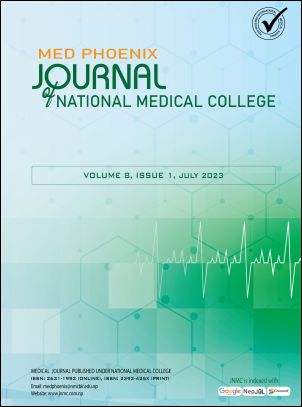Evaluation of Genitourinary Infection in Preterm Labour: A Descriptive Cross-Sectional Study
DOI:
https://doi.org/10.3126/medphoenix.v8i1.56925Keywords:
Preterm Labour, Prevalence, Urinary Tract InfectionAbstract
Introduction: Preterm labour is defined as the occurrence of regular uterine contractions (≥ 4 in 20 minutes or ≥ 8 in 1 hour) and cervical changes (effacement ≥ 80% and dilatation ≥ 1cm) in women with intact fetal membrane and gestational age less than 37 weeks. Genitourinary infection is the most important cause of preterm labour. The aim of this study was to determine the role of Genitourinary infection in causation of preterm labour.
Methods: This is a descriptive cross sectional study done at National Medical College Teaching Hospital from 10 November 2021 to 9 November 2022 after obtaining IRC (F-NMC/549/078-79). Total of 90 patients in preterm labour fulfilling the inclusion criteria were enrolled in this study after taking informed consent. Clinical examination was done, vaginal swab, endocervical swab and urine samples were sent to microbiological department for examination. Preformed proforma were used to record the demographic, clinical finding and result of investigation. The data was analyzed statistically using SPSS 22 and mean age, frequency and prevalence of genitourinary infection were calculated.
Results: In this study, 90 patients of preterm labour were enrolled. The mean age group of patients was 23.61 ± 4.25 years. Genital infection compromised of 41%, high vaginal swab showed 30% prevalence and endocervical swab showed 20% prevalence. The most common organism identified in genital infection was Gardenella vaginalis 55.55%. The prevalence of Urinary tract infection was 40% where E.coli was the most common organism 66.66%.
Conclusions: Genitourinary tract infection plays an important role in causation of preterm labour and can easily be diagnosed with routine urine examination, urine culture and vagino-cervical swab. The prevalence of genital infections and urinary tract infection was 41% and 40% respectively. Gardnerella vaginalis was the most common pathogen identified in genital tract whereas E.coli was leading cause of UTI in Preterm labour patients.
Downloads
Downloads
Published
How to Cite
Issue
Section
License
Copyright (c) 2023 Med Phoenix

This work is licensed under a Creative Commons Attribution 4.0 International License.
This license enables reusers to distribute, remix, adapt, and build upon the material in any medium or format, so long as attribution is given to the creator.
Copyright on any research article is transferred in full to MED PHOENIX upon publication. The copyright transfer includes the right to reproduce and distribute the article in any form of reproduction (printing, electronic media or any other form).




